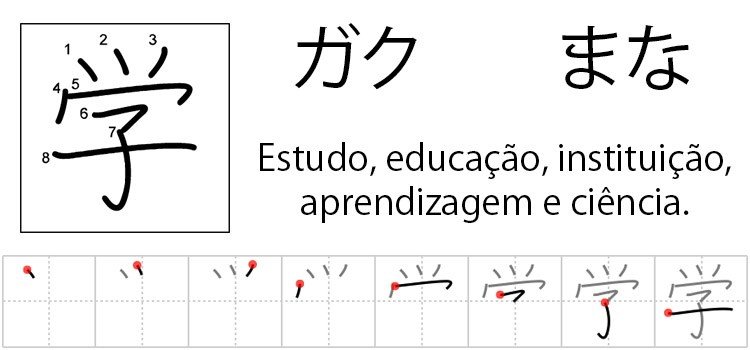Do you know what ON YOMI reading or KUN YOMI reading is? Ever wondered how the Japanese manage to read text without mispronunciation or stumbling? If you have studied Japanese for some time, you should know that kanji, or ideograms, are imported from Chinese, and have different pronunciations.
Kanji in the Japanese language is divided into 2 Readings:
- On yomi (音読み) - Reading by sound - These are readings of Chinese origin;
- Kun yomi (訓読み) - Untranslatable Semantic reading - These are readings of Japanese origin;
Because? When Chinese ideograms were imported into Japan, the Japanese associated the words already used in Japanese to the ideograms, and they also associated and converted the Chinese readings into the Japanese ideograms.
See the example of the ideogram east [東]. In Chinese it says "dong", this was converted into Japanese as "tou" becoming an ON reading. However, the Japanese already used "higashi" or "azuma" to refer to the east, so this ideogram ended up gaining these 3 and other pronunciations. Remember that the ON reading will always be written in Katakana, while the KUN reading in Hiragana.
Índice de Conteúdo
Tip on how to know when to pronounce ON and KUN
It is impossible to know precisely when to use ON or KUN reading in a word without knowing it. However, there is a tip that works for most words, but it is worth making it clear that it does not apply to 100% cases.
To know the reading of the ideograms for the most part, keep the following in mind:
- ON - É lido quando o Kanji está acompanhado de outro;
- KUN - It is read when the Kanji is accompanied by a hiragana;
O costume é ler toda palavra usando a leitura ON, mas em alguns casos ela pode terminar com a leitura KUN;
When ideograms are usually isolated, they are verbs or individual words that originated from ancient Japanese. ON reading, on the other hand, most of the time occurs when an ideogram is paired with another, because ON readings usually have 1 syllable, or as the name suggests, a sound.
The verbs, suffixes, and prefixes usually have the reading KUN. Remembering that a reading can also vary. It is worth remembering that people's names usually have other readings in addition to ON and KUN.
We recommend reading:
- The similar-looking ideograms and kanji
- How to Discover Kanji or Ideogram?
- Discovering the kanji reading by the phonetic component
Examples of Kanji with ON and KUN Readings
Below, see how knowing this will help us identify the reading of the Japanese ideogram. And also see how this tip doesn't work 100% sometimes.

See below the example of the ideogram that means study and learn in Japanese:
学 ON = gakko KUN = mana
- 学校 - school - School
- 学ぶ - manabu - learn Aprender (Usou kun porque está acompanhado de um hiragana (é um verbo);
Below we have the ideogram with the meaning of great and its readings ON YOMI and KUN YOMI:
大 ON = dai KUN = oo
- 大好き - daisuki - I love you (Used on, because it is accompanied by a kanji.)
- 大き - ooki - Large (Used "kun" because it is accompanied by a hiragana.)
Now let's see the example of the day and sun ideogram:
日 ON = nichi, jitsu KUN - hi, _bi, _ka
- 日曜日- untranslatable"you"bi - Sunday (Started using Chinese reading and ended using Japanese reading.
Below is an example of the person ideogram:
人 ON = jin, nin KUN = _to, hito, _ri
- Brazilian - burajirujin Brazilian (used the on without being accompanied by a kanji.)
- 二人 - futari - two people Two Persons (both used the kun reading.)
For this reason it is important to know the vocabulary, not all ideograms follow this rule.
Whenever you see a kanji followed by a hiragana, remember that your reading is probably Japanese (kun yomi).
And when you come across several ideograms forming a word, your reading is usually Chinese (on yomi), but your last ideogram can be a Japanese reading (kun yomi).
Knowing this makes us more confident in reading, and makes us not get lost when trying to figure out how to read a word.
Why did I decide to write this article?
Until today I have never found this small and simple tip in any book or course. Knowing when reading is ON or KUN helps a lot in learning ideograms and when pronouncing unfamiliar words. What do you think of this tip? Have you noticed that this is so?





